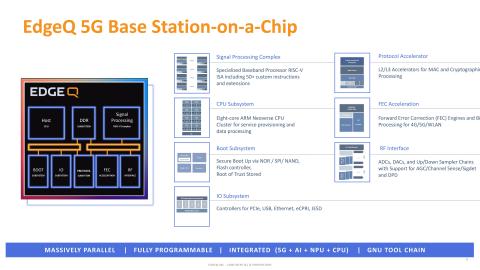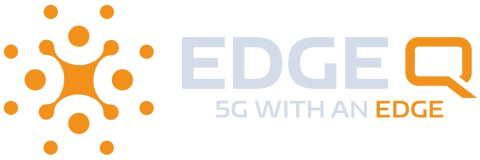EdgeQ Samples World’s 1st Software-Defined 5G Base Station-on-a-Chip
EdgeQ Inc, a leader in 5G wireless infrastructure, today announced sampling of its revolutionary 5G Base Station-on-a-Chip to Tier 1 customers deploying next-generation wireless edge networks for the enterprise, telco and cloud markets. EdgeQ is sampling the full suite solution to customers developing enterprise-grade 5G access points, Open-Radio Access Network (O-RAN) based Radio Unit (RU) and Distributed Unit (DU).
Successful deployment of Radio Access Networks (RAN) requires the availability and access to production-ready Physical Layer (PHY) hardware and software that governs all the essential protocols and features of 4G/5G. Traditional merchant silicon vendors offer the PHY as a reference software, placing the development burden on customers to invest years of effort to operationalize into production. By abstracting this friction with a total platform solution including a production-readied 5G PHY software, EdgeQ says that frees customers from the substantial investments, resources and time typically associated with productizing the 4G/5G PHY layer.

“Traditional market approaches offer baseband processing hardware and PHY software as separate topics, where the burden of proof rests on customers to fully productize and enable. EdgeQ has the ability and completeness to accelerate the market with a production-grade RAN stack that is also customizable and programmable,” said Chris DePuy, Technology Analyst at 650 Group. “The linchpin to lowering the 5G entry barrier is enabling operators and organizations with a total turnkey solution that is at the same time agile, flexible, and complete.”
Three years in the making, EdgeQ has been collaborating with market-leading wireless infrastructure customers to architect a highly optimized 5G baseband, networking, compute and AI inference system-on-a-chip. By coupling a highly integrated silicon with a production-ready 5G PHY software, EdgeQ uniquely enables a frictionless operating model where customers can deploy all key functionalities and critical algorithms of the radio access network such as beamforming, channel estimation, massive MIMO and interference cancellation out of the box.
For customers looking to engineer value-adds into their 5G RAN designs, the EdgeQ PHY layer is completely programmable and extensible. Customers can leverage an extendable nFAPI interface to add their custom extensions for 5G services to target the broad variety of 5G applications spanning Industry 4.0 to campus networks and fixed wireless to telco-grade macro cells. As an industry first, the EdgeQ 5G platform holistically addresses the pain point of deploying 5G PHY and MAC software layers, but with an open framework that enables a rich ecosystem of L2/L3 software partners.
“Since day one, EdgeQ has been relentless about redefining the consumption and deployment model of 5G with its RISC-V based open architecture that converges connectivity, networking, and compute. How we elegantly club the hardware, the deployable RAN software, and an innovative chipset-as-a-service business model all together is what crystallizes the vision in a disruptively compelling way,” said Vinay Ravuri, CEO and Founder, EdgeQ. “Our sampling announcement today signifies that all this is a market reality.”
About EdgeQ
EdgeQ is a leading innovator in 5G systems-on-a-chip. The company is headquartered in Santa Clara, CA, with offices in San Diego, CA and Bangalore, India. Led by executives from Qualcomm, Intel, and Broadcom, EdgeQ is pioneering a converged connectivity and AI that is fully software-customizable and programmable. The company is backed by leading investors, including Threshold Ventures, Fusion Fund and AME Cloud Ventures, among others.

To learn more about EdgeQ, visit www.edgeq.io.
References:
3 thoughts on “EdgeQ Samples World’s 1st Software-Defined 5G Base Station-on-a-Chip”
Comments are closed.



According to EdgeQ CEO Vinay Ravuri, the company has had its chip back in the lab for “about six weeks”.
“Within two weeks we actually got full Linux running and it looks solid, and we are able to send 5G traffic through the chip,” Ravuri told EE Times.
EdgeQ’s idea is to integrate the various chips that make up a basestation onto one piece of programmable silicon, thereby reducing the overall power consumption and cost of building a basestation.
EdgeQ’s evaluation card features its chip, plus baseband and RF components. Loading the EdgeQ chip with different firmware can change the system on the card from a distributed unit (DU) to a radio unit (RU) or access point (gNodeB).
The chip itself features a 50-core signal processor. The 50 RISC-V cores are identical and are dynamically programmable to process the phy layer features which are implemented in software. The core is licensed from Andes and customized with EdgeQ’s instruction extensions specific to 5G and AI workloads.
Instructions added by EdgeQ speed up mathematical operations including fast fourier transforms (FFT), complex modulations, approximators for non-linear functions, matrix decompositions and equalization. Some of these operations are common to 5G and AI workloads; the chip can be used to accelerate both.
EdgeQ’s chip also features a network on chip (NoC), RF interface, forward error correction (FEC) acceleration, protocol accelerator for L2/L3 and secure boot. A host processor, which is 8x Arm Neoverse cores, performs control and configuration functions such as user monitoring, traffic statistics, diagnostics and upgrading software on the chip. Ravuri said the decision to stick with Arm cores here (rather than move to RISC-V) is so that Tier 1 OEM customers could retain software they have already written for these functions that run on Arm.
“Almost all hardware companies today only do [hardware],” Ravuri said. “The [phy] layer is left up to the customer – we think that is the problem… If you did it that way, your customers would end up being Ericsson and Nokia again.”
EdgeQ has developed production-ready PHY software for its chip which can be deployed out of the box, including functionality such as beamforming, channel estimation, massive MIMO and interference cancellation. For customers who want to add their own differentiation, the EdgeQ PHY layer is programmable and extensible and can address the wide variety of 5G applications from Industry 4.0 to telco-grade macro cells.
EdgeQ operates a silicon-as-a-service model, meaning customers pay a nominal price for the chip which comes with a basic 5G implementation. Over time, customers can unlock more sophisticated features (such as low latency for AR/VR, location services, RAN sharing, slicing, machine learning, or custom functions for example) which are delivered via updated firmware.
“It became clear that 5G is so broad that not everybody wants to pay up front for everything,” Ravuri said. “They don’t want to pay for sophisticated features up front because they may not know what they’ll use it for.”
The additional features are “pay-as-you-go” meaning they can be switched off when not needed any more, saving customers money.
How are customers responding to this business model so far?
“It’s been a very pleasant experience on that front, I thought we might see friction or resistance, but no,” Ravuri said. “It’s true that [customer] supply chains aren’t set up for chips like this. One customer liked this model, but didn’t know how to manage a chip vendor through this model because they hadn’t done that before. They’ve opted to pay the subscription [for the features they need] up front instead.”
EdgeQ already has a design win with “a large North American OEM” who have committed to productizing the EdgeQ chip, Ravuri said.
The company’s headcount has grown to 120 people with offices in Santa Clara and San Diego, Calif. and Bangalore, India.
https://www.eetimes.com/edgeq-samples-5g-basestation-on-a-chip/#
“The additional features are ‘pay-as-you-go’ meaning they can be switched off when not needed any more, saving customers money.”
I wonder if this also means they can be turned off to reduce power consumption as well?
IEEE ComSoc and SCU will host a virtual panel session on Private 4G/5G and OpenRAN. We have confirmed participants from Nokia, Mavenir, Intel, and EdgeQ + analyst firm StrandConsult. If you’re interested in attending this FREE event (to be scheduled in late Feb) please email me: [email protected] & I will put you on the email invitation list.